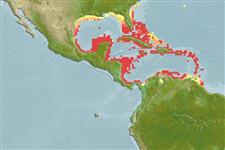>
Eupercaria/misc (Various families in series Eupercaria) >
Labridae (Wrasses) > Corinae
Etymology: Thalassoma: Greek, thalassa = the sea + Greek, soma = body; the colour of the sea (Ref. 45335).
More on author: Bloch.
Environment: milieu / climate zone / depth range / distribution range
Ecologie
marien rifbewoner; diepte 0 - 40 m (Ref. 9710), usually 3 - 30 m (Ref. 27115). Tropical; 23°C - 26°C (Ref. 27115); 34°N - 7°N, 99°W - 58°W
Western Atlantic: Bermuda, Florida (USA), southeastern Gulf of Mexico and throughout the Caribbean Sea to northern South America.
Grootte / Gewicht / Leeftijd
Maturity: Lm ? range ? - ? cm
Max length : 25.0 cm TL mannelijk / geslacht onbekend; (Ref. 26340); max. gerapporteerde leeftijd: 3.00 Jaren (Ref. 3420)
Korte beschrijving
Morfologie | Morfometrie
Dorsale stekels (totaal): 8; Dorsale zachte stralen (totaal): 12-13; Anale stekels 3; Anale zachte stralen: 10 - 11. Body elongate; 3 primary color phases, the smallest with a black mid-lateral stripe which continues as pale red blotches on head; back above stripe yellow on reef fish and whitish on fish from inshore non-reef areas, and body below white. The largest phase, has a bright blue head and a green body with two broad vertical black bars anteriorly which are separated by a light blue interspace; this phase is always male. The small yellow phase with the black stripe may be either male or female (Ref. 13442).
Inhabits reef areas, inshore bays and seagrass beds. Feeds mainly on zooplankton and small benthic animals, but may also feed on ectoparasites of other fishes (Ref. 9626). Spawn at midday throughout the year (Ref. 26938). A protogynous hermaphrodite (Ref. 55367). Generally of no interest to fisheries because of its small average size (Ref. 5217).
Levenscyclus en paargedrag
Maturiteit | Voortplanting | Paaien | Eieren | Fecunditeit | Larven
A diandric species (Ref. 55367). Sex reversal is completed in more than 3-4 weeks (Ref. 34185, 34257). Length at sex change = 8.3 cm TL, forms leks during breeding (Ref. 55367).
Robins, C.R. and G.C. Ray, 1986. A field guide to Atlantic coast fishes of North America. Houghton Mifflin Company, Boston, U.S.A. 354 p. (Ref. 7251)
Status op de Rode Lijst van het IUCN (Ref. 130435)
Gevaar voor de mens
Harmless
Gebruik door de mens
Aquarium: Commercieel
Meer informatie
ReferentiesAquacultuurAquacultuurprofielKweeklijnenGeneticaElectrophoresesErfelijkheidZiektesVerwerkingNutrientsMassaconversie
Tools
Speciale rapporten
Download XML
Internetbronnen
Estimates based on models
Preferred temperature (Ref.
123201): 25 - 28.1, mean 26.8 °C (based on 222 cells).
Fylogenetische diversiteitsindex (Ref.
82804): PD
50 = 0.5000 [Uniqueness, from 0.5 = low to 2.0 = high].
Bayesian length-weight: a=0.00891 (0.00512 - 0.01553), b=3.02 (2.87 - 3.17), in cm total length, based on LWR estimates for this species & Genus-body shape (Ref.
93245).
Trofisch niveau (Ref.
69278): 3.3 ±0.1 se; based on diet studies.
Generation time: 1.5 ( na - na) years. Estimated as median ln(3)/K based on 1
growth studies.
Weerstandsvermogen (Ref.
120179): Hoog, minimale populatieverdubbelingstijd minder dan 15 maanden (k=0.7; tmax=3).
Fishing Vulnerability (Ref.
59153): Low vulnerability (20 of 100).
Nutrients (Ref.
124155): Calcium = 75.2 [45.5, 123.9] mg/100g; Iron = 0.761 [0.447, 1.351] mg/100g; Protein = 18.6 [15.8, 20.8] %; Omega3 = 0.149 [0.100, 0.227] g/100g; Selenium = 32 [20, 56] μg/100g; VitaminA = 77.7 [25.7, 279.6] μg/100g; Zinc = 1.51 [1.07, 2.36] mg/100g (wet weight);
